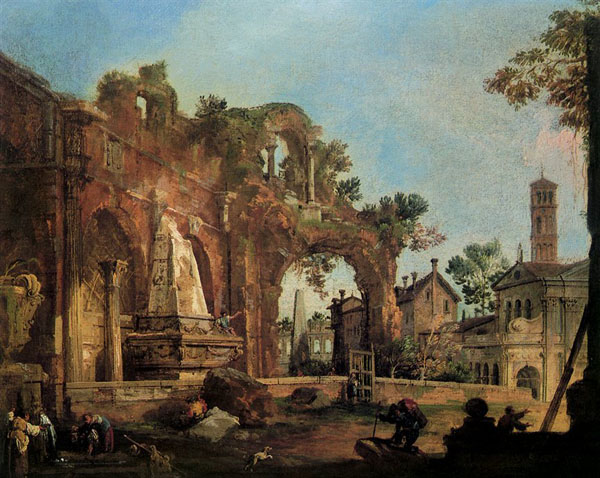48. Rome: a Caprice View with Ruins
based on the Forum, c. 1726.
Oil on canvas, 31.4 x 40.3 cm.
The Royal Collection, London.
More than anything, Pannini proved to be a proponent of landscape compositions, rooted in the monumental ruins and figures of Antiquity, and conceived with a studied knowledge of order and precisely measured levels of shadow. This master, nearly the same age as his new student, taught the latter a respect for nature and her patterns, instilling in him the genius of an architectural painter that the disciple would greatly develop and modify with the exactitude of his lines, the warmth of his colours, the virtuosity of his artistic touch, and the proportional harmony of his compositions. Moreover, Canaletto was only following the trend promoted by the geniuses of that time. Indeed, Marco Boschini came up with The Rich Miners while Tomasso Fontana gathered an abundance of documents for his invaluable work, Il Fiore di Venezia Ossia i Quadri, i Monumenti, le Vedute e i Coslumi Veniziani Rappresentati in due cento Incisioni e Seguite da Abili di Venezia;[10] and finally, the two volumes of Il Gran Teatro della Pitture e Perspettive de Venezia,[11] which was about to come out.
Settled in Rome with few financial resources, undoubtedly forced to take up his theatrical decorator brushes once again, he directed his own efforts to painting Christian and ancient architecture. Seduced by the monuments’ exterior appearance, he set up camp in front of the ruins and sketched for hours. There he would have often run into Pannini,[12] who, while creating imaginary scenes based on elements taken from reality, while grouping together the temples, columns and triumphal arches that Poussin and le Guaspre had hidden in the backgrounds of their paintings, knew how to develop a style marked by nobility in his architectural arrangements. Proud, and rightfully so, on account of his designation as a student of Locatelli (1693-c. 1741) and of the Florentine Benedetto Luti, Pannini did not take any less pride in his successes, which were growing every day, although his productions were sometimes rightfully accused of being inaccurate depictions, or more than that, too imaginary. He was, in his own way, an unorthodox illustrator who was quick to delude himself about the visions he thought he had translated to the canvas with exactitude. A member of the San Luca Academy of Rome, he preferred to exercise his ingenious talent within small dimensions, such as the challenge of confining the tragic grandeur of the Forum within a truly minuscule space. Pannini was quickly able to understand his new companion’s innate artistic sense. He inculcated in Canaletto his veneration for Salvator Rosa, demonstrating to his student the novel ideas in his paintings, which he reproduced with strangely Romanesque brushstrokes that were rather solemn, but which blended well with the archaic genre of rural painting.
But was Canaletto sufficiently learned in classical letters to understand how deeply emotions and memories could sink even into a simple stone? Indeed, it seems that Rome spoke less to his mind than to his eyes. What really seduced him in the Eternal City were the pleasant combinations of lines, the warm and harmonious tones of walls basking in the sun and the beautiful effects of lights on the façades. He never attempted those “mosaics” of patterns imaginatively but hazardously combining styles and subjects that seduced his companion. He felt powerless when it came to convincing his teacher that reality was beautiful enough to be painted without fanciful artifice. However, it did not take him long to recognize that Rome had not deeply moved his heart and that his soul had stayed back in the country of the lagoons. He was nostalgic for his tender Venice and longed to paint Saint Mark’s lion on top of its tall, marble post, the thin, copper roof of the bell tower covered in pistachio green oxidation and even the marvellous order of the Doges’ Palace, resting against the majesty of the most devoutly mosaicked basilica in the Christian world.
When working on stage decorations to support himself, his labour came markedly more slowly and less joyfully than when, in his father’s studio, he traced with a steady ruler the receding lines of cornices, accurately reproduced from the same perspective as his map of city squares and calli. He obsessed so much about returning to Venice that he suddenly resolved to end his stay in Rome so that he could return as soon as possible to his beloved Grand Canal and Giudecca, so turbulent along its shore next to the customs house, where he loved to fill his gaze with light, colour, and life.
It took him only a week to finish View of the Colosseum, which today can be seen in London, before he left the Eternal City behind. Rome’s environment was no longer agreeable to him; consequently, he never wanted to go back. How long was he with Pannini? Some estimate that his stay in the august city exceeded two years, explaining the numerous studies of Rome in Canaletto’s oeuvre. Though it is possible that he painted the city after his departure, based on his sketches, it seems likely, given that he worked relatively slowly, that he did not return to Venice until the beginning of the 1720s. The young stage decorator left the city taking with him all the resources found in the many paintings of Rome, planning to execute his own only later, whether in Venice or abroad.
